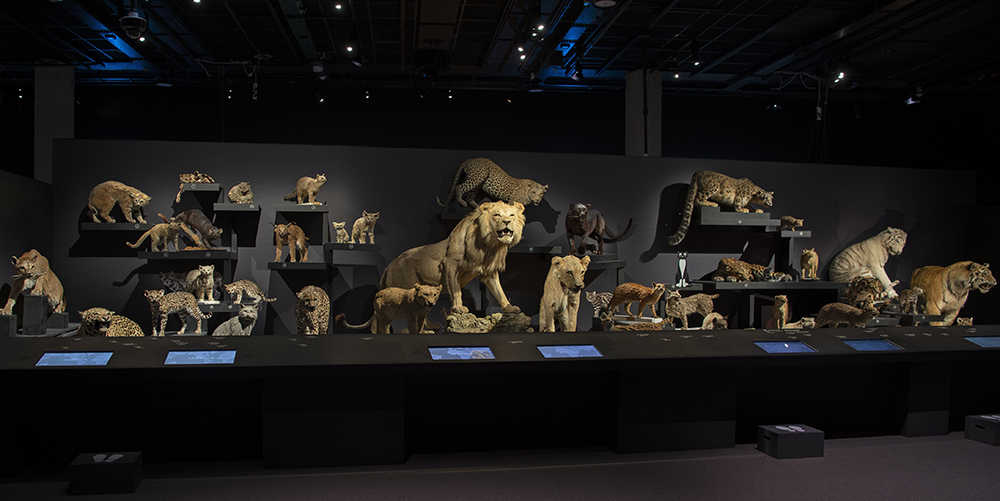The purr-fect exhibition for the whole family!

TORONTO, April 9, 2024 – They are wild ferocious predators with razor-sharp retractable claws—and they may be in your home! Domestic house cats (scientific name Felis silvestris catus) are just one of the felines set to take over ROM when Wild Cats opens June 15, continuing through to October 20, 2024. Wild Cats covers the story of the 38 current species of cats living today (extant), addressing their surprising diversity, hunting skill, agility, use in art and culture, and threats to their survival. This original exhibition is designed by the Muséum national d'Histoire naturelle, France, and adapted for display at the Royal Ontario Museum, with exquisite cultural objects added from ROM collections.
Wild Cats presents the amazing variety of cat species that exist around the world, including some impressive but less commonly known felines such as the tiny Kodkod (Leopardus guigna) from South America, and the fishing cat (Prionailurus viverrinus) from southern Asia. Guests will learn about the features that make them incredible predators. With highly developed senses, cats are stealthy stalkers, skilled in the chase and lethal in their attack. In addition to highlighting their natural abilities, the exhibition delves into the deep connection cats of all stripes have had with humans over the centuries, inspiring historical myths and legends, and permeating contemporary culture. This fascinating and ferocious world of the family Felidae will also be further experienced through the exhibition’s robust multimedia content and hands-on activities.
“From beloved pets to mythic figures, cats have long loomed large in human culture, imagination, and daily life,” says Josh Basseches, ROM Director & CEO. “This exhibition—with its astounding array of mounted specimens, digital experiences, and diverse works of art and culture—shows us why.”
Wild Cats delves into the story of cats and scratches the surface on the lore of lions from Africa, jaguars of South America and prehistoric sabre-toothed cats. As iconic and exotic as those species are, visitors will also encounter the wild cat species who inhabit Ontario: the bobcat (Lynx rufus), the Canadian lynx (Lynx canadensis), and possibly even cougars (Puma concolor)—with rare sightings in eastern Canada.
“As cute and loveable as my cat Purball is, I can see the wild independent streak connecting him to millions of years of shared evolution with other cat species,” says Kevin Seymour, ROM lead curator for this exhibition. “Even with his loud purring, affectionate leg rubbing and penchant for napping, it only takes a squirrel leaping outside my window to know he can be as ferocious as any lion on the hunt for gazelle.”
As reclusive as cats can be in the wilds of tropical jungles or boreal forests, they have a prominent role in society as symbols of used by rulers and as representations of deities. To supplement this exhibition, ROM has added art and cultural objects depicting cats and their various representations of prosperity, good luck, independence, rebirth, mystery, and power.
Displayed from ROM collections are objects from cultures around the globe that illustrate humans’ potent connections to cats.
- Mummified cats from Egypt were important religious items—they carried prayers, wishes, and thanks to Bastet—the cat goddess.
- In South Asia, big cats hold symbolic importance as emblems of strength and courage such as the figure of Boddhisattva Manjusri on a lion, from the region of Tibet, or the figure of Narasimha, from Himachal Pradesh, India, illustrating the Hindu god Vishnu as a ferocious part-man part-lion.
- Athenian vases depict the hero Herakles. In one he is fighting a Nemean lion and another shows him wearing a lion’s skin to take on the power of the animal for his other heroic tasks. Such depictions are emblematic of courage, victory, and power.
- Military badges from China, featuring various cats, were used to indicate the higher ranks of military officials during the Qing dynasty.
- A shield with four lions from the Qajar dynasty in Iran illustrates the wisdom of the Prophet Muhammad and the bravery of Shi’a Imam Ali.
Enhancing the exhibition are interactive elements, video displays, digital labels, and large-scale projections to bring the story of cats to life. These dynamic experiences will allow visitors to witness real examples of how cats hunt, sleep, jump, and train their cubs. Others tell stories of cats from different areas of the world, challenge human exploitation of big cats, and detail the challenges all cats face for their survival.
The survival of many wild cat species is uncertain, with several listed as endangered. They are threatened with habitat loss, hunting and conflict with livestock production. Wild cats were massively hunted in the 1800s and 1900s. Tigers, which once lived across the southern half of Asia, have disappeared from 95% of their historic territory. Although most species of wild cats are now protected by law, they are still killed illegally and suffer from continued destruction of their natural habitats.
Members will have the first opportunity to attend Wild Cats during the Member Preview on Friday, June 14 and Saturday, June 15, 10 am until noon.
Canada Cat Facts
- The Canada lynx (Lynx canadensis) primary prey is the snowshoe hare (Lepus americanus), whereas the bobcat (Lynx rufus) preys on a variety of species making it less dependent on the population cycles of snowshoe hares.
- Mountain lion/cougar (Puma concolor) is included on the Species at Risk in Ontario List. With a range that extends from Canada to southern Argentina, they are also known as pumas and panthers.
- Smilodon fatalis, commonly known as a sabre-toothed cat, once roamed the land now know as Canada and much of the Americas, from 2.5 million years until their extinction 11,000 years ago.

